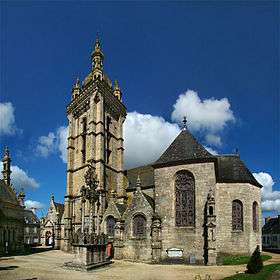Saint-Thégonnec
| Saint-Thégonnec Sant-Tegoneg | ||
|---|---|---|
|
Notre-Dame Church in parish close | ||
| ||
 Saint-Thégonnec | ||
|
Location within Brittany region 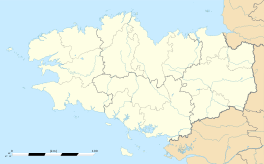 Saint-Thégonnec | ||
| Coordinates: 48°31′19″N 3°56′43″W / 48.5219°N 3.9453°WCoordinates: 48°31′19″N 3°56′43″W / 48.5219°N 3.9453°W | ||
| Country | France | |
| Region | Brittany | |
| Department | Finistère | |
| Arrondissement | Morlaix | |
| Canton | Saint-Thégonnec | |
| Intercommunality | Morlaix | |
| Government | ||
| • Mayor (2014–2020) | Solange Creignou | |
| Area1 | 41.76 km2 (16.12 sq mi) | |
| Population (2008)2 | 2,630 | |
| • Density | 63/km2 (160/sq mi) | |
| Time zone | CET (UTC+1) | |
| • Summer (DST) | CEST (UTC+2) | |
| INSEE/Postal code | 29266 / 29410 | |
| Elevation | 7–216 m (23–709 ft) | |
|
1 French Land Register data, which excludes lakes, ponds, glaciers > 1 km² (0.386 sq mi or 247 acres) and river estuaries. 2 Population without double counting: residents of multiple communes (e.g., students and military personnel) only counted once. | ||
Saint-Thégonnec (Breton: Sant-Tegoneg) is a former commune in the Finistère department in Brittany in northwestern France. On 1 January 2016, it was merged into the new commune Saint-Thégonnec Loc-Eguiner.[1]
The village is noted for its very elaborate parish close, one of a number in the area, which include Guimiliau and Lampaul-Guimiliau.
Population
Inhabitants of Saint-Thégonnec are called Saint-Thégonnecois.
| Historical population | ||
|---|---|---|
| Year | Pop. | ±% |
| 1793 | 3,291 | — |
| 1800 | 3,291 | +0.0% |
| 1806 | 3,422 | +4.0% |
| 1821 | 3,563 | +4.1% |
| 1831 | 3,648 | +2.4% |
| 1836 | 3,836 | +5.2% |
| 1841 | 3,926 | +2.3% |
| 1846 | 3,962 | +0.9% |
| 1851 | 3,802 | −4.0% |
| 1856 | 3,588 | −5.6% |
| 1861 | 3,957 | +10.3% |
| 1866 | 4,050 | +2.4% |
| 1872 | 3,681 | −9.1% |
| 1876 | 3,548 | −3.6% |
| 1881 | 3,409 | −3.9% |
| 1886 | 3,215 | −5.7% |
| 1891 | 3,317 | +3.2% |
| 1896 | 3,073 | −7.4% |
| 1901 | 3,144 | +2.3% |
| 1906 | 3,206 | +2.0% |
| 1911 | 3,171 | −1.1% |
| 1921 | 2,980 | −6.0% |
| 1926 | 2,977 | −0.1% |
| 1931 | 2,719 | −8.7% |
| 1936 | 2,536 | −6.7% |
| 1946 | 2,532 | −0.2% |
| 1954 | 2,241 | −11.5% |
| 1962 | 2,159 | −3.7% |
| 1968 | 2,127 | −1.5% |
| 1975 | 1,986 | −6.6% |
| 1982 | 2,133 | +7.4% |
| 1990 | 2,139 | +0.3% |
| 1999 | 2,267 | +6.0% |
| 2008 | 2,630 | +16.0% |
Breton language
The municipality launched a linguistic plan through Ya d'ar brezhoneg on 25 March 2005.
Parish close
A parish close is an enclosed area around the parish church, including the church yard and a number of other features.
In common with others in the area, the Saint-Thégonnec close features a large ceremonial entrance arch, stressing the importance of the close as a focus for pilgrimage and pardons. An impressive calvary or crucifix forms the focus of the church yard. As at nearby Lampaul-Guimiliau, there is a separate charnel house or ossuary, with a life-sized tableau of the Entombment of Christ.
The interior of the church is exemplary of the local version of Baroque style, with a large quantity of polychrome sculpture and decoration, including a spectacular pulpit.
See Saint-Thégonnec Parish close
See also
- Communes of the Finistère department
- Parc naturel régional d'Armorique
- Yann Larhantec Sculptor of Calvaries including one in Saint-Thégonnec
- List of the works of the Maître de Plougastel
- List of the works of the Maître de Thégonnec
References
- ↑ Arrêté préfectoral 23 December 2015 (French)
 The church and entrance to parish close.
The church and entrance to parish close.- Ceremonial entrance arch.
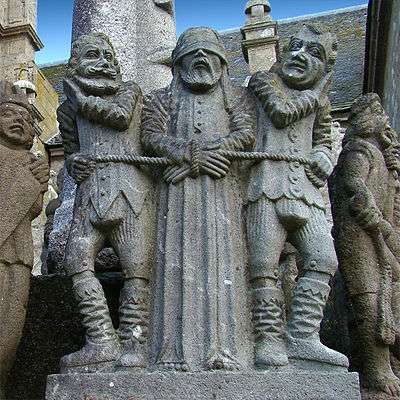 Detail of calvary.
Detail of calvary.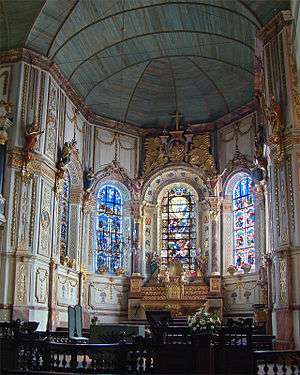 The choir.
The choir. Retable of the Rosary.
Retable of the Rosary. Retable of the Holy Sacrament.
Retable of the Holy Sacrament.
- Folding triptych of the Madonna and Child in the parish church.
 St Mark, from a set of Four Evangelists decorating the pulpit.
St Mark, from a set of Four Evangelists decorating the pulpit.
 Polychrome decorative moulding from the pulpit.
Polychrome decorative moulding from the pulpit.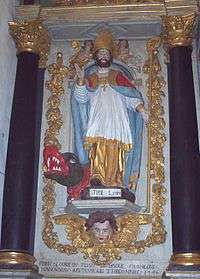
 Polychrome statue of St Christopher and the infant Christ in the parish church.
Polychrome statue of St Christopher and the infant Christ in the parish church.
Twin city
 Silverton, Devon, England, since 2008.
Silverton, Devon, England, since 2008.
External links
| Wikimedia Commons has media related to Saint-Thégonnec. |
